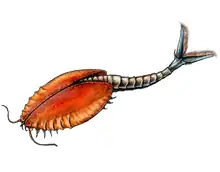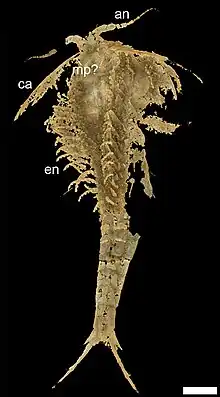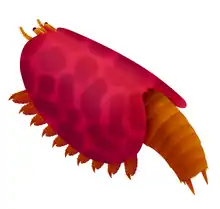Ercaicunia
Ercaicunia is genus of bivalved Cambrian arthropod from the Chengjiang biota of Yunnan, China. It contains a single species, E. multinodosa that was described by Luo et al. in 1999.[1] The total length of the body ranges from 8 to 11 millimetres (0.31 to 0.43 in). The bivalved carapace covered about a third of the total body-length, and has up to six serrations on its forward edge. The head has a pair of large uniramous antennae, as well as a smaller pair of secondary antennae, as well as pair of mandibles and maxillae. The trunk has 16 pairs of biramous appendages. Specimens were CT scanned in 2019, which suggested it to be a stem-group crustacean.[2] Other subsequent studies have recovered it as a member of Hymenocarina, which contains other bivalved Cambrian arthropods.[3][4]
| Ercaicunia Temporal range: | |
|---|---|
 | |
| Artist's restoration | |
 | |
| Tomographically scanned specimen | |
| Scientific classification | |
| Kingdom: | |
| Phylum: | |
| Order: | |
| Genus: | †Ercaicunia |
| Species: | †E. multinodosa Luo et al, 1999 |
References
- Luo, HL; Hu, SX; Chen, LZ; Zhang, SS; Tao, YH (1999). "Early Cambrian Chengjiang Fauna From Kunming Region, China" (in Chinese). Kunming: Yunnan Science and Technology Press. S2CID 133363305.
{{cite journal}}: Cite journal requires|journal=(help) - Zhai, Dayou; Ortega-Hernández, Javier; Wolfe, Joanna M.; Hou, Xianguang; Cao, Chunjie; Liu, Yu (January 2019). "Three-Dimensionally Preserved Appendages in an Early Cambrian Stem-Group Pancrustacean". Current Biology. 29 (1): 171–177.e1. doi:10.1016/j.cub.2018.11.060. PMID 30595518.
- -López, Alejandro Izquierdo (July 15, 2022). "Extreme multisegmentation in a giant bivalved arthropod from the Cambrian Burgess Shale". iScience. 25 (7): 104675. Bibcode:2022iSci...25j4675I. doi:10.1016/j.isci.2022.104675. PMC 9283658. PMID 35845166.
- Izquierdo‐López, Alejandro; Caron, Jean‐Bernard (November 2021). Zhang, Xi‐Guang (ed.). "A Burgess Shale mandibulate arthropod with a pygidium: a case of convergent evolution". Papers in Palaeontology. 7 (4): 1877–1894. doi:10.1002/spp2.1366. ISSN 2056-2799. S2CID 236284813.
